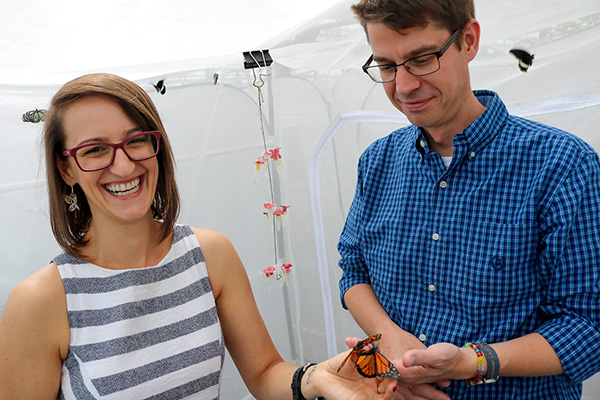Single gene controls variety of wing patterns across butterfly species

A single gene is responsible for producing different wing patterns, shapes and colors across several butterfly species, scientists report this week in a new study published in the Proceedings of the National Academy of Sciences.
Using CRISPR/Cas9 gene editing tools, researchers from seven institutions knocked out a gene called WntA in embryos from seven different butterfly species, essentially turning it off. The resulting adult butterflies developed changes in wing patterns and colors that differed in each species, suggesting that while WntA plays a fundamental role in wing patterning across butterfly species, it has been used in a variety of ways.
"Every butterfly has a unique color pattern and there is extraordinary diversity among species, but they're not reinventing the wheel when it comes to developing those unique color patterns," said Marcus Kronforst, PhD, associate professor of ecology and evolution at the University of Chicago and an author on the study. "In the case of WntA, they're using that one gene again and again and again."
Previous genetic studies have identified WntA as the gene that controls patterns of melanin, or dark pigmentation, in the wings of Heliconius butterflies. The widespread group of species lives throughout the tropical and subtropical regions of North and South America. Other studies have also pinpointed the role of WntA in wing patterning of other groups, suggesting that it is widely conserved across all butterfly species.
Until recently, however, scientists lacked the tools to directly test of function of this gene in butterflies. For the new study, coordinated by Arnaud Martin from the George Washington University, each research team from seven different institutions chose a different butterfly species and used the CRISPR gene editing system to knock out WntA.
Kronforst and Darli Massardo, PhD, a postdoctoral fellow at UChicago, worked with monarch butterflies. The loss of WntA caused the monarch's characteristic orange scales to turn white, but didn't change the overall pattern of the wings. Another team worked with painted lady butterflies, which lost the usual black spots in the middle of their wings. Other species developed differently shaped bands across the wings.

"When we knock out the gene, we're seeing totally different effects," Massardo said. "So, although WntA is involved in wing-patterning in general, it's doing fundamentally different things in different species."
Kronforst and Massardo say that the results of this study give scientists insight into the process of evolution, as butterflies exploit the utility of this gene to develop multiple wing patterns. The widespread use of precise genetic tools like CRISPR will allow them to explore this process further, moving beyond simple knockout experiments to more complex, functional changes.
"Now we're just altering the gene to make it nonfunctional," Kronforst said. "But what we'd really like to do are things like precisely put in a copy of the same gene from another species or another color pattern and see what that does. This just opens the door for us."
The study, "Macro-evolutionary shifts of function potentiate butterfly wing pattern diversity," was supported by the National Science Foundation, the National Institutes of Health, the Leverhulme Trust, the Pew Charitable Trust, a Nigel Groome PhD studentship and the Smithsonian Institution. Additional authors include Anyi Mazo-Vargas, Linlin Zhang and Robert Reed from Cornell University; Carolina Concha from North Carolina State University; Luca Livraghi and Casper Breuker from Oxford Brookes University; Richard Wallbank and Chris Jiggins from the University of Cambridge; Joseph Papador, Daniel Martinez-Najera and Nijam Patel from the University of California, Berkeley; and W. McMillan from the Smithsonian Tropical Research Institute.

